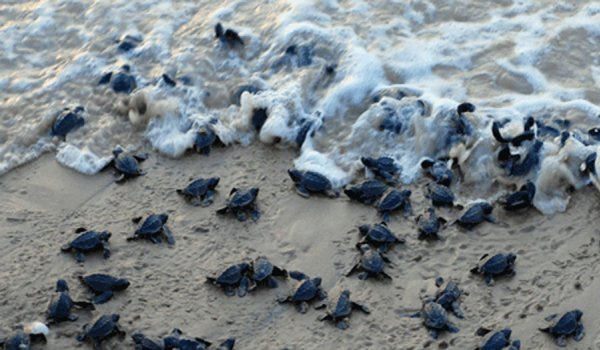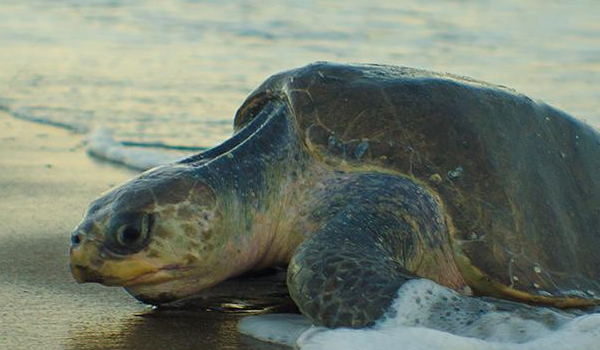Samikhsya Bureau
It goes on uninterrupted each year. Some antes are upped by the wildlife officers engaged with the task of protection of the Olive Ridley turtles while mating in the deep sea, yet there has been no year in the calendar when the tragic sight of the dead turtles do not dot the shores. It is either in Gahirmatha, supposedly the largest rookery for them, or Rushikulya river mouth or even in Devi river mouth, it is all the same.
Every year along the Odisha coast more than 10,000 sea turtles (Olive Ridley) die un-natural deaths due to an illegal fishing activity, is a shocking reality. Few media high lights and then after the usual self-approvals for a good job and over.
A specie that is legally protected under Wildlife Protection Act (1972) as Schedule 1 specie, that existed even before dinosaurs, is something we should not allow to perish so soon.
Their survival for us is as important as the species like dinosaur which, perhaps, suffered extinction due to various reasons including the climatic disorder. Going by a study, it was perhaps over several million years ago dinosaurs and few more flora and fauna disappeared for ever.
Come December, the sight of dead Olive Ridley turtles grows and slowly has becomes a common sight along the coasts and river mouths. Be it Rushikulya, Debi river mouth or along the coast in Gahirmatha , such sights are given less and less attention.
For the wildlife department it has, down last many years, the casualties remained confined to statistics and the government, as a whole, has never laid emphasis to arrest or minimize the causes of such unnatural deaths due to rampant illegal fishing activities.
Barring a few reported seizures of fishing vessels including trawlers , rest enjoy a free run.
One of the oldest living species, Olive Ridley is one of the many such species like Leather-back, Loggerheads, Hawksbill and few others dating back to the period much before the time of Dinosaurs.
As regards the Olive Ridley turtles, the coasts of Odisha so far remained as the safe destination for nesting and among them, Gahirmatha, Rushikulya and Debi river mouths are prominent sites the Olive Ridleys have developed the homing instinct for many years.

After mating off-shore, the females arrive at the beach where they dig holes in the sand to lay eggs. When their hatchlings emerge, they drift off with the tidal waves and migrate to their feeding grounds several thousand kilometers away.
Although there is no empirical study to ascertain the numbers but, thousand of turtles head for the coasts of Odisha for nesting between December and April. There are two factors those mainly remain conducive for these visitors; first is homing instinct and the second is safety.
Sometimes, what adds to their problem is the literal drift that result in disappearance of certain nesting hubs and often creation of new hubs, as it is noticed in the Gahirmatha expanse where the sea, more often than not, remain prone to tidal invasions.
How can the damages be reduced
Illegal fishing by motorized boats and fishing trawlers are few of the principal reasons behind the deaths. Mainly before the month when the turtles keep mating in the deep sea, they face the accidents by such vessels and get fatally injured or die.
The prohibitions on fishing in the deep sea at such times are never enforced with the seriousness required to be attached and the result is obvious. Ironically many of them get entangled in the fishing nets and often die of asphyxiation and injuries.
Besides the unnatural deaths, the other ominous reason that looms over this innocent specie is the demand of their eggs. Each turtle lays eggs numbering about 100 to 150 in the pits and many of them are devoured by the animals on the beach and the other, is the high protein eggs in demand and also the demand of turtle meat in parts of West Bengal .
A study had showed that over 50,000 turtles are transported from the coasts of Odisha to Kolkata during the nesting season every year. And all that goes off the vigil tangent of the forest and wildlife department or , as alleged, they chose to look the other way from such activities.

Demand for its meat and eggs had raised eyebrows and then under Appendix 1 of Convention of International Trade in Endangered Species of Wildlife flora and Fauna of which India is a part. Yet somehow, lack in the grassroot vigil either by the Wildlife or the Fisheries department remains as the major bottleneck.
Nesting sites often fall victim to some literal drifts, born out of oceanic storms, erosion of beaches and surge of commercial activities around that creates disturbances through illumination etc. Oil spill from the mechanized vessels is a growing threat for the turtles. What had transpired into a regulation prohibiting deep sea fishing within 20 kms of Gahirmatha coast and other such coasts where turtles come for nesting.
High mortality of hatchlings
Other major threat for the Olive Ridley population is the rising mortality of hatch lings of turtles after they emerge out of the egg pits and in some cases when they fail to emerge out the pits because of compaction of sand particles.
Born in crores each year lakhs of them get either buried and in few cases once out of the pits they fall prey to predators or lose direction of the sea and get killed.
Which naturally has become a major set-back for the turtle conservation because the survival rate of hatch lings is frightening as one in thousand hatch lings succeed to reach adulthood.
If the state can propound a theory like 5T to streamline the sectors coming within it, why not some ‘T’ for the safety of poor turtles rather than leaving the task entirely to the department in which officers prefer the cushion of a stay in Bhubaneswar to the interiors where they should be.
It is time the authorities also emerge out their hard-shelled complacency to enforce a fool-proof conservation and protection. Else,if this specie goes the dinosaurs’ way , may be, history will never forgive us.




